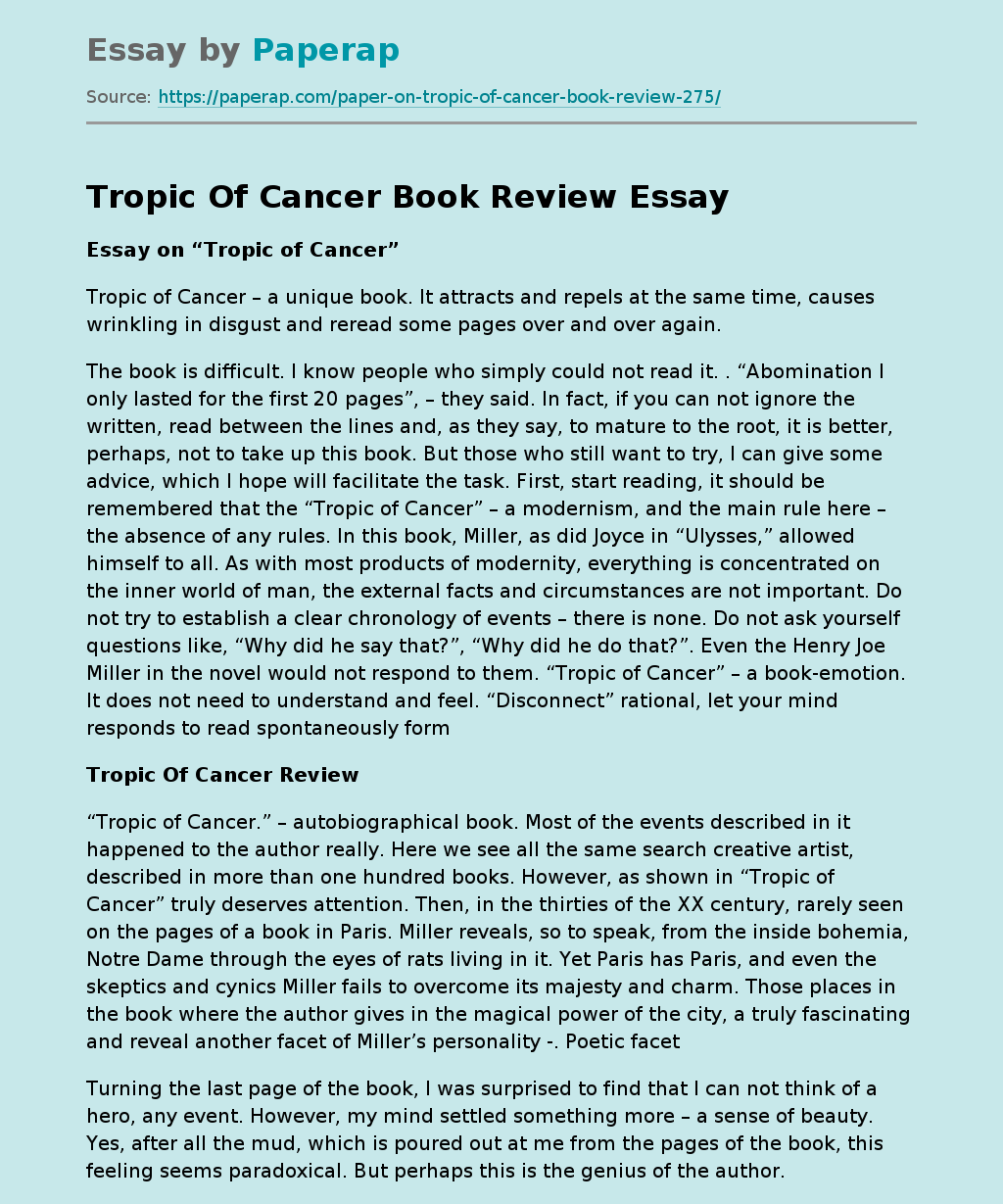Henry Miller’s “Tropic of Cancer” is not merely a novel; it is a visceral exploration of the human condition, a fervent odyssey into the labyrinth of art, love, and existentialism. Emblazoned with Miller’s distinctive prose, the book delineates the life of an American expatriate navigating the underbelly of Paris during the 1930s. Upon sifting through its pages, one cannot help but be entranced by the raw candor that permeates his reflections—a narrative that tantalizes the senses while simultaneously delving into the psyche of its protagonist.
At its core, the novel embodies a sense of liberation paralleled by an undeniable disillusionment. The protagonist, also named Henry, grapples with the dualities of existence—joy and despair, creation and destruction, love and solitude. This kaleidoscope of experience invites readers to ponder a fundamental question: Why are we so deeply fascinated by tales of unfiltered human experience? The answer lies nestled within the intricate layers of Miller’s prose, where the mundane metamorphoses into the profound through the lens of suffering and joy.
Miller paints a vivid tableau of Paris, infusing each description with an authenticity that breathes life into the city itself. The streets, the cafes, the shadows—each element becomes a character in its own right, resonating with the heartbeat of life. This careful crafting of setting is not merely for picturesque effect; it serves a deeper purpose. As Miller’s narrative unfolds, the city morphs into a metaphor for the tumultuous journey of artistic creation. The streets signify the chaotic pursuit that often accompanies the desire to produce something beautiful amidst a milieu of hardship.
The emotional candor with which Miller writes beckons readers to confront their own vulnerabilities. His exploration of complex relationships—rife with sexual tension, unrequited love, and fleeting encounters—offers a profound commentary on the intricate web of human connections. These relationships are seldom idealized; rather, they are depicted in their raw and often tumultuous state. This unvarnished depiction resonates deeply, as it reflects common experiences while inciting a contemplation of the deeper, often unarticulated, motives behind human interactions.
This propensity for candidness draws us in, illuminating our proclivity to find refuge in the narratives of others. One cannot help but ponder the archetypal figure of the tortured artist represented through Henry. It taps into a long-standing cultural fascination with the idea that profound suffering begets remarkable art. Yet, Miller challenges this notion, illustrating the dualities inherent in creation—a simultaneous yearning for connection and an unwavering solitude. As readers, we are encouraged to reckon with the paradox of the artist: Do they create from a place of pain, or does creation itself become a source of solace?
In declaring himself a “cancer,” Miller imbues the narrative with a visceral sense of anxiety and urgency that echoes the existential dread many experience. This characterization is a striking metaphor that speaks to the unsparing realities of existence. The notion of cancer transcends the biological, evolving into a symbol of an insatiable hunger for experience—an embodiment of humanity’s quest for meaning amidst chaos. This relentless pursuit invites readers to probe their own existential dilemmas, urging them to reflect on the innate struggle between reflecting societal norms and embracing personal liberties.
The interplay of freedom and constraint becomes a recurring theme throughout “Tropic of Cancer.” The protagonist’s life is riddled with contradictions; he yearns for freedom yet remains tethered by financial instability, societal expectations, and intimate entanglements. This tension mirrors a common observation in modern society—many seek liberation from societal constraints, while simultaneously feeling the weight of those same shackles. Miller’s narrative instigates a profound contemplation on what true freedom entails, prodding readers to evaluate their own lives in the context of boundless potential yet limited by self-imposed barriers.
Furthermore, Miller’s unabashed exploration of sexuality is not gratuitous; rather, it serves as a conduit for engaging with broader themes of companionship and isolation. The libidinal fervor that courses through the narrative highlights how desire intertwines with the quest for authenticity. Miller eloquently articulates the beauty and horror of intimate connections, navigating the jagged landscapes of physicality and emotional resonance in a manner that is both hallowed and haunting. This portrayal resonates deeply, as it reflects a universal quest for intimacy in an increasingly fragmented world.
Moreover, the book serves as a socio-political commentary, juxtaposing personal narratives against the backdrop of a pre-war Europe. The subtle tensions of class struggle, artistic elitism, and cultural disparities infuse the text with a critical dimension that merits examination. Miller’s critique of bourgeois values articulates a pervasive discontent that continues to echo through modern society, raising urgent questions about artistic integrity, authenticity, and the societal constructs that often suffocate creativity.
In conclusion, “Tropic of Cancer” stands as a monumental work that transcends the confines of its time, addressing universal themes through the lens of personal experience. Miller’s exploration envelops readers in a passionate, often unsettling journey that is as much about the human experience as it is about the act of creation itself. It invites readers to immerse themselves in an exploration of identity, desire, and the quest for meaning amidst life’s paradoxes. The perennial allure of this work lies not solely in its narrative, but in the deeper truths it unveils—truths that resonate with the tumultuous and exhilarating experience of being human.
